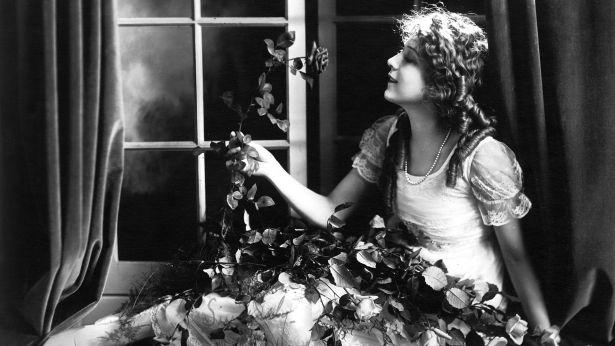You know, I’m honestly not sure if I’ve ever seen a Mary Pickford movie? She was an extraordinarily busy woman in the old days, making a total of 185 shorts between 1909 and 1918 (plus one in 1930) and 62 features from 1911 to 1933. She produced 35 from 1915 to 1949, mostly uncredited. In her first year in film, she made 51 shorts. She was one of the founders of the Academy and one of the founders of United Artists. She helped sell Liberty Bonds during World War I and came up with the idea of the Motion Picture Relief Fund. In short, there was a heck of a lot more to her than a head of ringlets.
She started acting on the stage at seven. (Or five, if you believe the hype, which you shouldn’t; she routinely lied about her age.) In fact, she pretty well supported her family, eventually getting careers for her mother, brother, and sister. It’s difficult to say for sure, because records weren’t meticulously kept and are had to compare in any event, but it seems probable that she and Charlie Chaplin remain two of the biggest box office draws of all time. Yes, her career mostly went out with the coming of sound—which she disliked intensely—but that seems in part because she didn’t really want to change. She spoke in despairing terms of Chaplin’s decision to retire the Tramp and said he never should have played Hitler, for example.
She didn’t always play children—though she did play Little Lord Fauntleroy—but she did tend to play the young and innocent. Those who expected her to be like that in her professional life would become aware of their mistake in no uncertain terms. She was already signing her own contracts as a minor, though the courts invalidated that. At least one Los Angeles banker believed she knew more than anyone he’d met about LA real estate. She gave up her childhood to support her family, and it meant getting seriously cutthroat if she had to.
Though it’s worth noting that she retained sympathy for those who hadn’t been able to make it themselves. She didn’t believe that everyone was capable of reaching her level of success and financial status. She was lucky and talented. She knew that, and she saw it as her responsibility to help those not so fortunate—hence the Motion Picture Relief Fund, intended for the benefit of movie people who were destitute. She’d seen the ups and downs of the film industry a time or two, and she seems not to have liked the idea of people dying of starvation when the industry could help them out.
It amuses me that her penultimate short was 1918’s “One Hundred Percent American,” given that she definitely was not, and at the time wasn’t even a US citizen. She was born in Toronto. While her marriage to Douglas Fairbanks brought American citizenship, she decided she wanted to die a Canadian. She gained dual citizenship in the last years of her life. While she is buried in Glendale, California, at Forest Lawn, she indeed died a Canadian and is part of Our Canadian Heritage.
Help support my family; consider supporting my Patreon!

